Dripping or flinging paint; flipping coins to compose musical scores; letting the progressive decay of organic materials determine a composition — since the early 20th century avant-garde artists have used these processes and many others to explore the creative possibilities of chance and its attendant release of authorial intent. This fall the Mildred Lane Kemper Art Museum at Washington University in St. Louis will present Chance Aesthetics, a major loan exhibition investigating the use of chance as a key compositional principle in modern art.
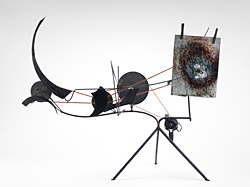
Jean Tinguely, *Metamatic No. 9* (1958). Round rubber belt, steel rods, painted sheet metal, wire wooden pulleys, two clothes pins and electric motor, 35 1/2 x 56 5/8 x 14 1/4″. Museum of Fine Arts, Houston. Gift of D. and J. de Menil.
Organized by Meredith Malone, assistant curator for the Kemper Art Museum, Chance Aesthetics will feature more than 60 artworks by more than 40 avant-garde artists from Europe and the United States, including Jean Arp, George Brecht, John Cage, Marcel Duchamp, Max Ernst, Ellsworth Kelly, Alison Knowles, François Morellet, Robert Morris, Robert Motherwell, Jackson Pollock, Dieter Roth, Niki de Saint Phalle and Yves Tanguy, among many others.
At the exhibition’s heart is a central paradox involving the tension between chance and choice. While many artists have championed the creative possibilities of the arbitrary and the accidental — both as an attack on reason and logic and as a counterpoint to officially sanctioned aesthetic tastes — artistic subjectivity is never entirely ceded. The controlled and the arbitrary variously interplayed throughout the 20th century, stimulating new forms of creative invention that challenged longstanding assumptions about what might constitute a work of art and the role of the artist as autonomous creator.
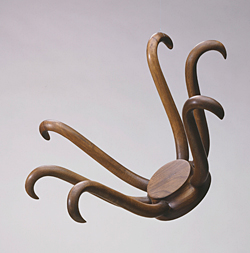
Marcel Duchamp, *Hat Rack* (1964; 4th version of 1917 original). Wood, 8/8, 9 7/16 x 17 5/16 x 13″. Indiana University Art Museum: Partial gift of Mrs. William H. Conroy.
Chance Aesthetics explores these ideas in three thematic sections: “Collage, Assemblage and the Found Object,” “Automatism” and “Games and Systems of Random Ordering.” Each section addresses key avant-garde strategies designed to subvert or rework traditional forms of artistic expression as well as the bourgeois values and ideals they were understood to represent. These categories also provide a basic framework through which individual movements — including Dada, Surrealism, Abstract Expressionism, Nouveau Réalisme and Fluxus — can be traversed, allowing viewers to compare and contrast the use of chance-based processes across diverse historical and cultural contexts.
“Collage, Assemblage and the Found Object” examines three closely related practices employed by artists as means of destabilizing accepted views of the world through fragmentation and juxtaposition while negating traditional criteria for judging a work of art such as the direct trace of the artist’s hand. Marcel Duchamp’s Hat Rack (1917) and Jean Arp’s Objects Arranged according to the Laws of Chance III: Symmetrical Configuration (1931) provide early touchstones, informing a wide range of subsequent artworks. Particularly in the post-WWII era, assemblage, coupled with chance—as evinced in works such as Daniel Spoerri’s snare paintings and Niki de Saint Phalle’s shooting paintings—offered artists a compelling means of social critique as well as a strategy for pushing the trajectory of artistic production toward process, performance and ephemeral events.
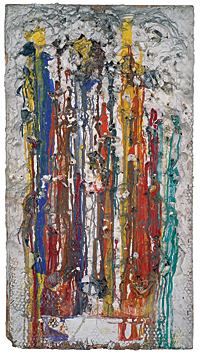
Niki de Saint Phalle, *Grand tir—séance Galerie J,* (June 30—July 12, 1961). Plaster, paint, wire mesh, string and plastic, 56 5/16 x 30 5/16″. Niki Charitable Art Foundation.
In his 1924 “Manifesto of Surrealism” André Breton defined Surrealism as “psychic automatism in its pure state.” Appropriated first from physiology and psychiatry, the term “automatism” was applied to various techniques of spontaneous writing, drawing and painting. Examples range from André Masson’s sand paintings and automatic drawings to Max Ernst’s otherworldly frottages (rubbings). Intended to bypass the conscious mind, these Surrealist experiments later were adapted by Abstract Expressionists such as Jackson Pollock, who explored chance effects of gravity and momentum on falling paint. But by the late 1950s diverse responses arose in opposition to the Surrealist legacy, including Swiss sculptor Jean Tinguely’s humorous production of painting machines, which took aim at both postwar gestural abstraction’s heroic mark-making and the supposed liberations of automatic production.
The final section, “Games and Systems of Random Ordering,” examines chance as generated through the implementation of randomizing systems and procedures. Though parameters typically were stipulated in advance, results were left largely to serendipity. Duchamp’s promotion of nonintention on the part of the artist and his notion of “canned chance,” which describes processes that depend on chance yet paradoxically attempt to fix or standardize it, aptly characterize many of the artistic practices represented. The type of indeterminacy derived from games and arbitrary systems of order—such as the simple toss of a coin, where one of two outcomes is equally likely—provided John Cage, Ellsworth Kelly, François Morellet and other artists with a means of undermining concerns of style and personal expression, thus facilitating the liberating exploration of unorthodox methodologies for making art.
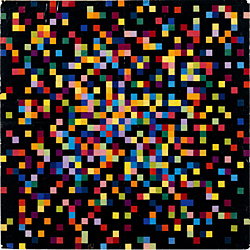
Ellsworth Kelly, *Spectrum Colors Arranged by Chance V,* 1951. Collage on paper, 39 x 39″. Collection of the artist. © Ellsworth Kelly.
CATALOG
A fully illustrated color catalog — distributed by the University of Chicago Press — accompanies the exhibition. Essays by Susan Laxton, Meredith Malone and Janine Mileaf draw connections across media and disciplines while linking the genesis and meaning of artistic production through chance to larger socio-cultural, historical and theoretical contexts. The catalog also features extended entries on all works in the exhibition, focusing on the processes employed and the rhetoric used to describe and theorize them.
ADDITIONAL EVENTS
In conjunction with Chance Aesthetics, the Kemper Art Museum will host a series of lectures, discussions and special events. On Sept. 23 Malone will moderate a faculty panel discussion exploring chance, randomness and probability as they relate to the disciplines of art, music, literature, architecture and anthropology. On Oct. 7 the university’s Department of Music in Arts & Sciences will host a Chance Aesthetics Concert, which will include experimental works by John Cage and other composers.
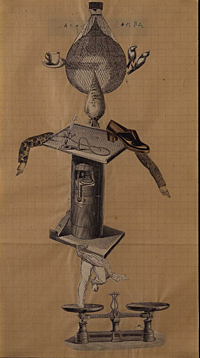
Victor Brauner, Jacques Hérold, Violette Hérold, Yves Tanguy and Raoul Ubac, *Untitled “Cadavre exquis” (“Exquisite Corpse”),* 1938. Graphite and collage on paper, 10 3/8 x 8 1/16″. Collection of Howard and Mauree Miller, Pennsylvania.
On Oct. 14 the Chess Club and Scholastic Center of Saint Louis will co-sponsor “Playing with Chance: Duchamp, Chess and Roulette.” The event will include a live chess match with Jennifer Shahade, two-time U.S. Women’s Chess Champion, who will combine the ultimate game of strategy with the ultimate game of chance by employing a specially designed roulette wheel to determine her moves and those of her opponent. Following the match, Bradley Bailey, assistant professor of art history at Saint Louis University — and co-author, with Shahade, of Marcel Duchamp: The Art of Chess — will host a gallery talk on Duchamp’s work.
On Nov. 9 the Department of Art History & Archaeology in Arts & Sciences will co-sponsor a talk by Yve-Alain Bois, the eminent critic and specialist in 20th-century European and American art, currently on faculty at the Institute for Advanced Study in Princeton, NJ. Tricia Y. Paik, assistant curator of modern and contemporary art for the Saint Louis Art Museum, will discuss Ellsworth Kelly and Chance Aesthetics Nov. 18. On Dec. 2 the museum will host a poetry workshop exploring how poets historically have integrated chance into their artistic practice, followed Dec. 4 by an informal poetry reading.
MILDRED LANE KEMPER ART MUSEUM
The Mildred Lane Kemper Art Museum, part of Washington University’s Sam Fox School of Design & Visual Arts, is committed to furthering critical thinking and visual literacy through a vital program of exhibitions, publications and accompanying events. The museum dates back to 1881, making it the oldest art museum west of the Mississippi River. Today it boasts one of the finest university collections in the United States.
Chance Aesthetics will open with a reception from 7 to 9 p.m. Friday, Sept. 18, and remain on view through January 4, 2010. Both the reception and exhibition are free and open to the public. The Kemper Art Museum is located on Washington University’s Danforth Campus, near the intersection of Skinker and Forsyth boulevards. Regular hours are 11 a.m. to 6 p.m. Mondays, Wednesdays and Thursdays; 11 a.m. to 8 p.m. Fridays; and 11 a.m. to 6 p.m. Saturdays and Sundays. The museum is closed Tuesdays. For more information, call (314) 935-4523 or visit kemperartmuseum.wustl.edu.
|
WHO: Mildred Lane Kemper Art Museum WHAT: Exhibition, Chance Aesthetics WHEN: Sept. 18 to Jan. 4, 2010; Opening 7 to 9 p.m. Friday, Sept. 18. WHERE: Mildred Lane Kemper Art Museum, Washington University, near the intersection of Forsyth and Skinker boulevards HOURS: 11 a.m. to 6 p.m. Monday, Wednesday and Thursdays; 11 a.m. to 8 p.m. Fridays; 11 a.m. to 6 p.m. Saturday and Sunday. Closed Tuesdays. COST: Free INFORMATION: (314) 935-4523 or kemperartmuseum@wustl.edu |
Editor’s note: High-resolution images are available upon request.